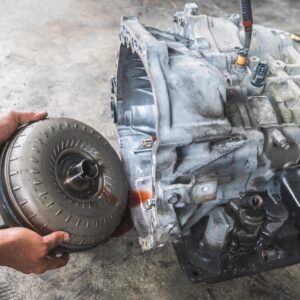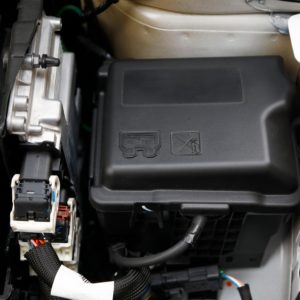Lug nuts keep your vehicle’s wheels in place, and it’s important that they’re always properly fastened. These little pieces of metal lock the wheels to the wheel studs on the hub using torque. Too much or too little lug nut torque will have an effect on how securely they’re fastened. That’s why it’s important to properly adjust the torque of your lug nuts.
The right torque for lug nuts generally depends on the lug nut’s bolt or stud size. We’ve prepared a table for easy reference. Remember though that this is not what to torque your wheels to, but a reference to the possible torque. Different vehicles require different torques. For instance, Subaru’s required torque is 65 lb-ft. Older Honda’s are generally 80 lb-ft, with the newer ones needing 100 lb-ft now. Toyota has been about 80 lb-ft for most. A lot of Chevy cars and light trucks are 100 lb-ft, with the larger trucks needing 145 lb-ft. Sprinter vans need 170 lb-ft.
How Much Torque Should I Use For Lug Nuts?
Most vehicles have lug nuts that require around 100 pound-feet of torque. However, certain vehicles require more or less. It’s best to check your vehicle’s manual to find out the exact specifications you need.
The right torque for lug nuts generally depends on the lug nut’s bolt or stud size. We’ve prepared a table for easy reference:
| Lug Nut Bolt or Stud Size | Required Torque Range |
|---|---|
| 7/16 in | 70-80 lb-ft |
| 1/2 in | 75-85 lb-ft |
| 9/16 in | 135-145 lb-ft |
Subarus are 65 ft-lb, while Hondas were generally 80 ft-lb until the newer ones and are around 100 ft-lb now. Toyota has been about 80 ft-lb for most models. A lot of Chevy cars and light trucks are 100 ft-lb. The larger trucks are 145 ft-lb, while Sprinter vans are 170 ft-lb.
–Anthony Harlin, ASE Certified Master Automobile Technician

How Often Should Lug Nuts Be Torqued?
It’s important to properly torque your lug nuts when installing new wheels. In addition, only torquing new wheels once isn’t enough. The rim might settle after the first few miles, leading to a small gap between the rim and the hub and eventually to loosened lug nuts. The vibration might also cause this looseness. That’s why many manufacturers recommend re-torquing your lug nuts after driving 50 to 100 miles on new wheels.
Whenever you have tire maintenance done, you can check the torque on your lug nuts again just to be safe. For installing and checking on your lug nut torque, use a torque wrench.
How To Use a Torque Wrench
Using a torque wrench might seem complicated at first, but it’s easy enough once you understand the tool. First you need to figure out what size torque wrench to use for your lug nuts. You’ll need to use a 1/2-inch torque wrench for most wheels.
Next, you can set the torque by twisting the bottom of the wrench. You might need to unscrew the knob at the very end of the wrench before adjusting the torque. You’ll notice that there are notches near the end of the wrench’s shaft. These notches will have corresponding numbers in intervals of 10. Twisting the handle of the wrench will move the handle up and down this line of numbers.
What we’ve just described is a click style torque wrench and should be set back to the lowest setting on the torque wrench after use to keep the calibration. There’s also a beam style torque wrench which is not a turn style, and that torque wrench does not need to be set to the lowest setting after use.
There are more notches and numbers on the rotating handle, this time in intervals of one. Use both the numbers on the shaft and on the rotating handle to set your torque. For instance, to set the torque to exactly 100, twist the handle until the 0 on the rotating handle and the 100 on the shaft are aligned. To set the torque to 95, first align the 0 on the handle to the 90 on the shaft, then twist the handle slowly until the 5 is aligned with the line in the middle of the shaft.
Risks of Improperly-Torqued Lug Nuts
Manufacturers designed lug nuts to ‘stretch’ to a specified amount when they’re torqued properly. This results in a strong mechanical connection to the lug’s threads. An under-torqued lug nut lacks this connection because it doesn’t have that stretch. As a result, the connection is loose and the lug vibrates and moves around more. These vibrations can eventually lead to the wheel unseating from the hub, which places pressure on the lugs that they weren’t designed for. The affected wheel could ultimately fail as a result.
Over-torqued lug nuts, on the other hand, are stretched too much by the pressure, weakening the lug nut’s tensile properties. This makes the bolts more likely to crack, shear, or separate violently from the lug. These stretched lug nuts can lead to warped brakes from uneven load distribution. In addition, over-torqued lug nuts can result in wheel loss.
While they’re just a small part of your vehicle, lug nuts play an important role in keeping you safe while driving. Make sure they’re properly torqued all the time.
Any information provided on this Website is for informational purposes only and is not intended to replace consultation with a professional mechanic. The accuracy and timeliness of the information may change from the time of publication.






























